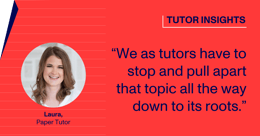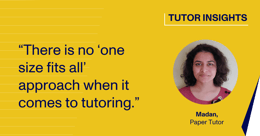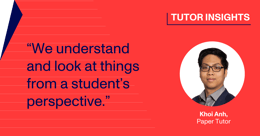
3 steps for nonfiction reading comprehension
Emma, a tutor at Paper, breaks down the three steps to reading success when approaching more complicated, higher-level nonfiction texts.
It’s the truth: Nonfiction can be hard!
Reading nonfiction texts for class—whether it’s a chapter from a history textbook, a social sciences article, or even a philosophical argument—can be tough and tiresome for some learners. It’s especially common to discover that reading assignments become longer and more technically difficult in high school.
After all, complicated argumentative structures and unfamiliar academic language can be frustrating. And when a student is overwhelmed by the assigned reading, it’s much more difficult for them to complete their coursework.
Learning how to read well in the humanities and in social sciences is often a matter of learning how to be patient and persistent. The ability to properly understand a text doesn’t happen instantly—it can be a slow process that takes real effort. But patience and persistence pay off!
This is something that I emphasize when I help students with reading comprehension. Educators can encourage careful and thoughtful reading habits that help students build confidence while they read, setting the groundwork for developing critical reading skills that will benefit them both within and beyond the classroom.
Because reading comprehension is so important, I suggest a three-step reading process. Here’s how I break it down for my students:
1. The quick skim
First, begin by quickly skimming the introduction and the conclusion of the text.
During this brief phase, identify the thesis statement and take note of how the selection is organized. Is it divided into subsections? If so, are the subsections titled in a way that suggests something about the author’s argument?
Especially if the text is long, beginning with a brief glance at the conclusion can function as a helpful mental boost. You’ll already know where the author ends up before you actually start reading, which means that you’ll often find it easier to comprehend arguments in the middle of the text.
2. Cursory reading
The goal for your cursory read—in other words, your first read—is to begin reading at the start of the text and make it to the end of your assigned material. Read the entire article, but remind yourself not to get bogged down in the finer details.
When you reach a section you don’t fully understand, you have two options:
- Spend a minute or two working on the problem area.
- Flag it with an annotation and save it for your close read.
When you get discouraged or feel as though you might be too lost, remind yourself that your immediate aim is to make it to the end of the article. After that process is complete, you can return to sections you’re still struggling with. Oftentimes, something that seems very confusing at the start of an article will be explored in greater depth later in the material. This is why it’s important to not give up too quickly!
3. The close read
After you’ve read the article once, consider jotting down a few takeaways. You might write the main argument in your notes, for instance, and think of a few questions that occurred to you during your first read.
After that, return to the text to dig in more thoroughly. Focus on where you’ve annotated in the margins, and spend more time thinking about the topic. You can also do additional research about technical language that might have gone over your head during the first read. Start to think carefully and critically about the author’s argument and what kinds of support they offer to bolster their claims.
If you’re reading the article to complete a specific assignment, this is when you can turn to the question you need to focus on and begin to narrow the scope of your research. Direct your attention from the article as a whole to the areas of the reading that will be most important for your assignment. Importantly, the close read should be tailored to the specific purposes of your reading.
Building students up—one step at a time
Reading and analyzing an article in separate steps makes long, dense, or otherwise difficult texts less intimidating. In my opinion, this is one of the great advantages of the above method. It gives students the tools to dive in without fear of the unknown—or, perhaps more accurately, this method helps reduce reluctance and uncertainty. It’s almost as if you’re diving into the text equipped with a trusty pair of water wings.
For readers who need help raising their confidence, the first step of this method can be a breath of fresh air. What better way to familiarize yourself with an article than by skipping directly to the end? Then, the student’s curiosity is piqued, and they’re supported by the following steps as they delve into the finer details of the text.
Reading comprehension is an open-ended process—not a fixed point of mastery or perfect understanding. Each student on the Paper platform brings a different perspective to the material they read, and they all approach their reading assignments with varying levels of prior knowledge and engagement with the material. This reading strategy is flexible enough to meet students where they are, which is why I incorporate it into my sessions!

Emma, Paper Tutor
Paper supports students and educators in school districts by providing unlimited 24/7 multilingual live help and essay review.
Who are our tutors?



.png?width=260&height=136&name=Blog-Tutor-Insights-Olivia%20(3).png)


.png?width=260&height=136&name=Blog-Tutor-Insights-Steve%20(1).png)